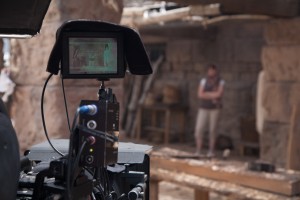
Travis Cluff describes himself as “a PG-13 kind of guy” — and that’s why the Hollywood writer and director took extra care while creating his film, “The Gallows.”
A husband, father and faithful member of The Church of Jesus Christ of Latter-day Saints, Cluff said “every precaution was taken” to make sure “The Gallows” received a PG-13 rating from the Motion Picture Association of America.
“Horror movies actually tend to do a little better with an R rating,” he said. “But that kind of content isn’t what we’re about.” Cluff and his co-creator Chris Lofing (also Mormon) wanted to make a scary movie that didn’t rely on graphic violence, sexuality or language to excite the audience.
They made a conscious effort while filming to remove R-rated content from the set, hoping the terror would speak for itself.
Apparently, the terror spoke too loudly. The MPAA gave “The Gallows” a restricted rating, claiming the film was too scary to be PG-13, despite its lack of R-rated content.
“We were all shocked,” Cluff said. “Especially the two Mormon guys who did everything they could to stay below that line.”
Some may wonder why Cluff and Lofing felt so concerned that their movie avoid the R rating. The content of a film is the same regardless of what letter the MPAA puts on the poster — but for many Latter-day Saints, it’s not that simple.
“A lot of people within the church take (a movie’s rating) as gospel,” Cluff said.
In 1986, President Ezra Taft Benson advised the young men of the church to avoid R-rated movies, and ever since, many have seen that restriction as the scarlet letter of the LDS movie-rating law.
That can be a bad thing, according to Jana Riess, an LDS professor of religious studies at Miami University in Ohio. Riess said President Benson’s counsel was “intended for youth,” and that because of it, “Mormons have extrapolated that all R-rated movies are bad, for all people, all the time.”
Riess also voiced frustration with inherent flaws in the rating system.
“(The rating system) was not created by Mormons for Mormons; it was created by Hollywood for primarily commercial reasons … I find it terribly ironic that we’re often so critical about Hollywood’s negative influence in the world, yet so quick to trust their judgment.”
Cluff cited that irony when the MPAA gave his movie a restricted rating.
“There’s not any kind of divine revelation or intervention involved in the process,” he said. “It’s five to 10 guys, sitting in a room, giving their best opinions about a particular film.”
Cluff said he doesn’t take the MPAA’s word when deciding which movies to watch. “I research the content,” he said. “If I feel something’s going to offend the Spirit, I don’t watch it, regardless of its rating.”
When a movie’s rating becomes the litmus test for its acceptability, viewers are likely to ignore the more important factor — its content.
“I know a lot of people here who won’t watch any R-rated movies but will watch anything rated PG-13,” said Kevin Judd, a BYU junior majoring in chemical engineering. “We’ve drawn this line that was clearly never meant to be drawn, and now we think that anything up to that line is OK.”
Judd said he has felt inspired by several R-rated films. “A lot of people would say you can’t feel the Spirit in an R-rated movie, but it seems silly to think that the Spirit would base its outpouring on what Hollywood says.”
Many use this R-rated line as a rationalization to watch any and all PG-13 films. But according to Cluff, the line may have an even worse impact on the other end of the spectrum.
“(A restricted rating) doesn’t necessarily mean the content is objectionable,” he said. “Look at ‘The Passion of the Christ,’ for crying out loud. R-rated movies are meant for mature audiences, and many Mormons miss out on great works of art because they mistake mature content for bad content.”
Riess said the judgment surrounding movie ratings — in both directions — needs to stop.
“If someone judges me, an adult member of the church, for watching an R-rated movie, they’re unfairly holding me to their own standards. But if someone else decides for themselves that they don’t want to watch R-rated movies, I should show them the same respect that I want.”
Elder Lynn G. Robbins of the Quorum of the Seventy addressed the issue of movie ratings in a 2013 BYU devotional.
“It is risky for the church to draw a line,” Robbins said. “If the speed (limit) on the freeway is 65 miles per hour, how fast will people drive? Well, they will feel free to drive as fast as the limit. If the church were to draw a line with movies, that would be like giving permission to watch everything up to the line. President Gordon B. Hinckley never drew a line. Neither has President Thomas S. Monson. But the prophets have taught us principles.”
Cluff agrees that the church has taught its members correct principles.
“We need to make good decisions based on good information,” he said. “If we allow the MPAA to become our conscience, we’re going to walk into things we shouldn’t be seeing, and we’re probably going to miss out on things that will help us better understand and appreciate our existence.”




